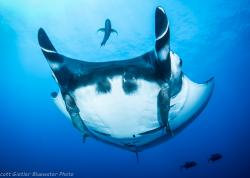Understanding Exposure
Exposure can be defined as the amount of light your camera lets in for any given shot. In the old days, "the exposure" was another term for your photo that was produced by your camera.
Alternatively, you can say it's the amount of light that hits your camera sensor. Exposure is one of the most important things for an underwater photographer to master.
What is a good exposure?
When people talk about having a good exposure, they mean that their photo is not too dark and not too bright.
But what is a good exposure? A good exposure can be defined as a an exposure that gives your photo the tonal values and colors that you imagined when you took the shot. Many people will tell you correct exposures are defined by a histogram. In the end, a good exposure is defined only by your judgment. A histogram can be very helpful in telling you what kind of exposure your photo has.
The definition of a proper exposure is an exposure that matches the exactly what the photographer's vision was. Even the best camera will not automatically expose a photo in the way a creative photographer imagined the scene, which is why photographers often take control of the exposure.

The four factors of underwater exposure
Shutter speed, aperture, and ISO all affect your exposure. If you are using a strobe, then the strobe power is also a 4th (and major) factor in your exposure.
- Shutter Speed
- Aperture
- ISO
- Strobes
Shutter Speed
Shutter speed is typically used to blur or freeze motion, reduce camera shake and/or to control ambient light in the image. When the camera shutter is opened, light enters through the aperture of the lens. The slower the shutter speed is the more time light is allowed to reach the sensor therefore the brighter the image.
Read the detailed tutorial on understanding shutter speed here.
Aperture 'f stops'
The aperture of your lens is like a curtain that can be opened in varying sizes. The size of an aperture is referred to as an F-stop. Your lens will have the largest aperture printed on it such as "f/2.8".
A "stop" is a relative term. Making a photo one "stop" brighter means you are letting in twice as much light. Making a photo a stop darker means you are letting in half as much light. People will often say "go up one stop" or "go down one stop" or "make it one stop brighter".
Read the detailed tutorial on aperture here.
ISO
Base ISO is the ISO at which your camera will have the optimal amount of noise, dynamic range and color sensitivity. Base ISO on most cameras is ISO 100. On high end dSLRs it is ISO 50.
Read more on ISO and noise here.
Strobes
Strobes are used to properly light your subject underwater bringing out its true colors. It can be tricky however, because it is easy to 'blow out' or over expose your image if the strobe power is too high or underexpose if too low.
Read more on lighting with strobes here.
Exposure Value (EV) and Exposure Compensation
EV stands for "Exposure value", which is the amount of brightness in a photograph. Changing either the shutter speed, ISO, aperture, or strobe power, depending on the circumstance play a role in the exposure value. When a camera is set to "automatic", the camera will choose what is best in each situation. However, in auto or manual mode you can choose to darken or lighten the image in-camera digitally with exposure compensation. Refer to your camera's manual for its specific settings.
Understanding Exposure
Proper exposure is when all of the above elements work together seemlessly. Having an understanding of how each one operates or how they affect your image is important in achieving the intended exposure every time.

RECOMMENDED ARTICLES
SUPPORT THE UNDERWATER PHOTOGRAPHY GUIDE:
The Best Service & Prices on u/w Photo Gear
 Visit Bluewater Photo & Video for all your underwater photography and video gear. Click, or call the team at (310) 633-5052 for expert advice!
Visit Bluewater Photo & Video for all your underwater photography and video gear. Click, or call the team at (310) 633-5052 for expert advice!
The Best Pricing, Service & Expert Advice to Book your Dive Trips
 Bluewater Travel is your full-service scuba travel agency. Let our expert advisers plan and book your next dive vacation. Run by divers, for divers.
Bluewater Travel is your full-service scuba travel agency. Let our expert advisers plan and book your next dive vacation. Run by divers, for divers.




































